
It’s no secret that defects are ever-present in software development.
From the first line of code to the last, developers and QA specialists face numerous obstacles and errors along the way—and those problems aren’t always easy to fix.
Bug reporting and bug and issue tracking are the tools that teams use to keep track of these problems, ensuring that they don’t make their way into production.
If one does manage to slip by undetected and appear in front of the users, they also help them to get to the bottom of it and fix it.
Below we’ll look at each of these concepts and how they are similar and different from one another, so keep reading to find out more!
Table of Contents
Bug vs issue: what is the difference
Before we get into the topic, let’s first distinguish bugs from issues.
At first glance, they’re not that inherently different because they’re both problems that need to be resolved. However, their scope is where they diverge.
Let’s see what this means.
A bug is usually defined as an error in the code that causes unexpected or undesired behavior when executing a specific task.
For example, in the image below when a user clicks on the button nothing happens because, as you can see, there is no link associated with it.
That means that there is presumably a bug in the code that is preventing the button from working properly.
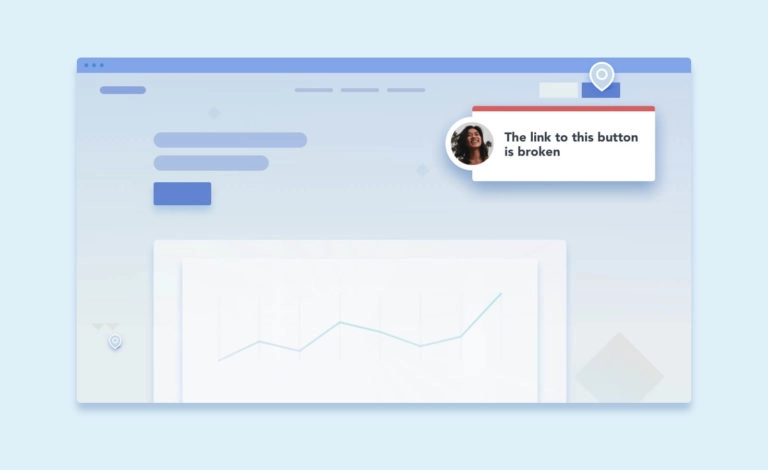
Bugs can range from minor annoyances, like typos, to major malfunctions that cause systems to crash entirely.
Actually, they come in many different shapes and sizes, including:
- Syntax bugs where a developer makes a syntax error and the code doesn’t work
- Logic bugs where there is an error in how the code is structured
- Runtime bugs which occur when the software runs but does not produce the expected result
Different types of bugs arise during different stages of the development process and are usually discovered by developers or QA specialists as a result of code reviews or testing.
On the other hand, an issue has a much broader meaning than a bug, referring to any perceived problem that requires attention.

Get unreal data to fix real issues in your app & web.
As such, issues may be related to a bug but could also involve documentation errors or feature requests.
They might concern questions that users ask or problems they’ve been having with the software—in short, anything that needs to be addressed.
For example, if you look at the picture below, you’ll notice that in Jira issues are classified into five different types: user stories, tasks, bugs, subtasks, and epics.
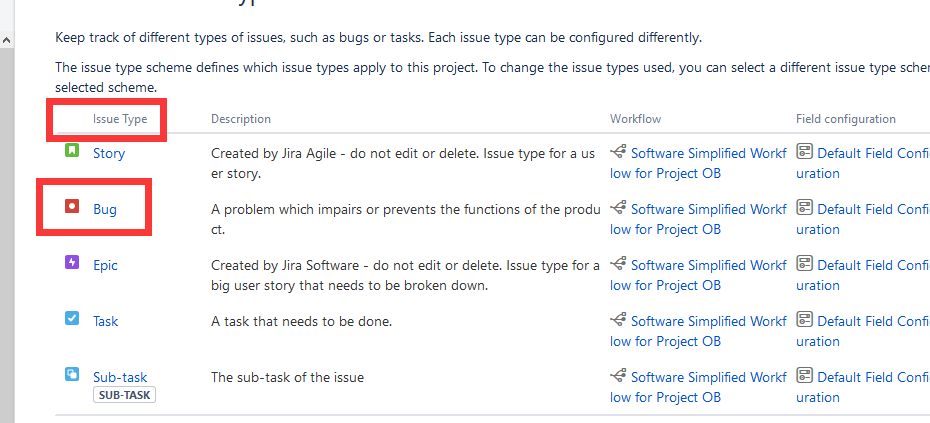
While the first four are fairly straightforward, the epic issue type is a higher-level issue that groups stories, tasks, and bugs together because it’s a larger problem that spans multiple smaller issues.
This classification is important because it shows the true relation between issues and bugs—bugs are only a subcategory of issues.
Additionally, it reveals where the issues come from. They aren’t only technical in nature such as bugs.
They can also originate from user stories and be related to user expectations and business requirements.
All in all, although the terms “bugs” and “issues” are sometimes used synonymously, they actually refer to two different things.
While bugs are a specific type of issue that is more technical in nature, issues encompass many different kinds of problems, not just technical ones.

What is bug reporting
When people usually think of bug reporting, they often imagine finding a flaw in software and then filing a report to alert the developers.
In reality, the process is far more involved, consisting of writing extensive reports that include relevant details about the bug (such as what happened and how), so it can be reproduced.
It’s often stressed that without well-written bug reports, developers may struggle to fix bugs.
But, why is that so?
The answer is pretty obvious: developers use bug reports to track bugs and other errors in their code.
A good bug report, like the one pictured below, will enable them to easily reproduce, diagnose and fix the bug, saving them hours upon hours of their time that would otherwise be spent in a needless effort to recreate the bug themselves.
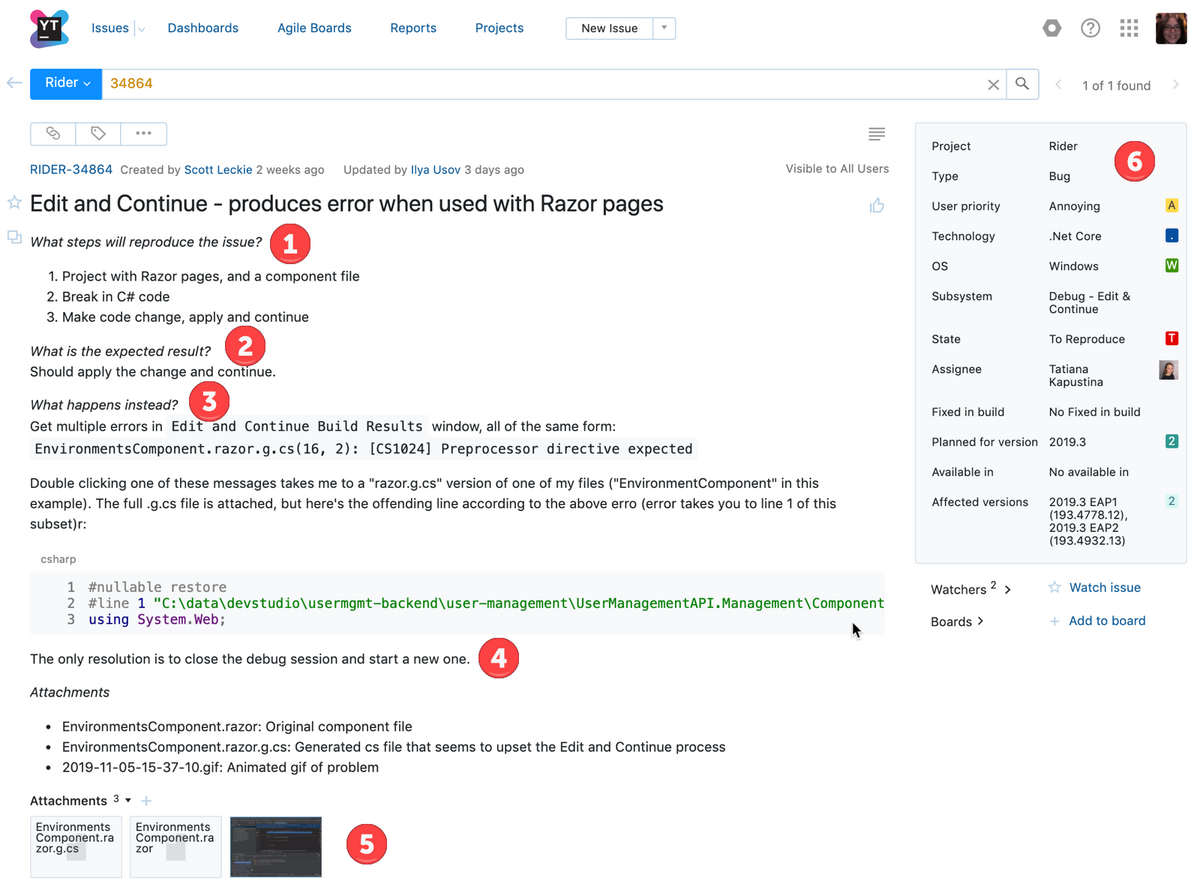
With that in mind, QA specialists often rely on automation that helps them write better bug reports and deliver more accurate information to the developers.
Bug and crash reporting tools, such as our very own Shake, have the ability to automatically capture specific information about bugs, such as the environment in which they occurred, what device was used, and what operating system.
For example, if you’re testing your mobile app with Shake, all you have to do is shake the phone, and the tool will automatically attach the following information to the bug report:
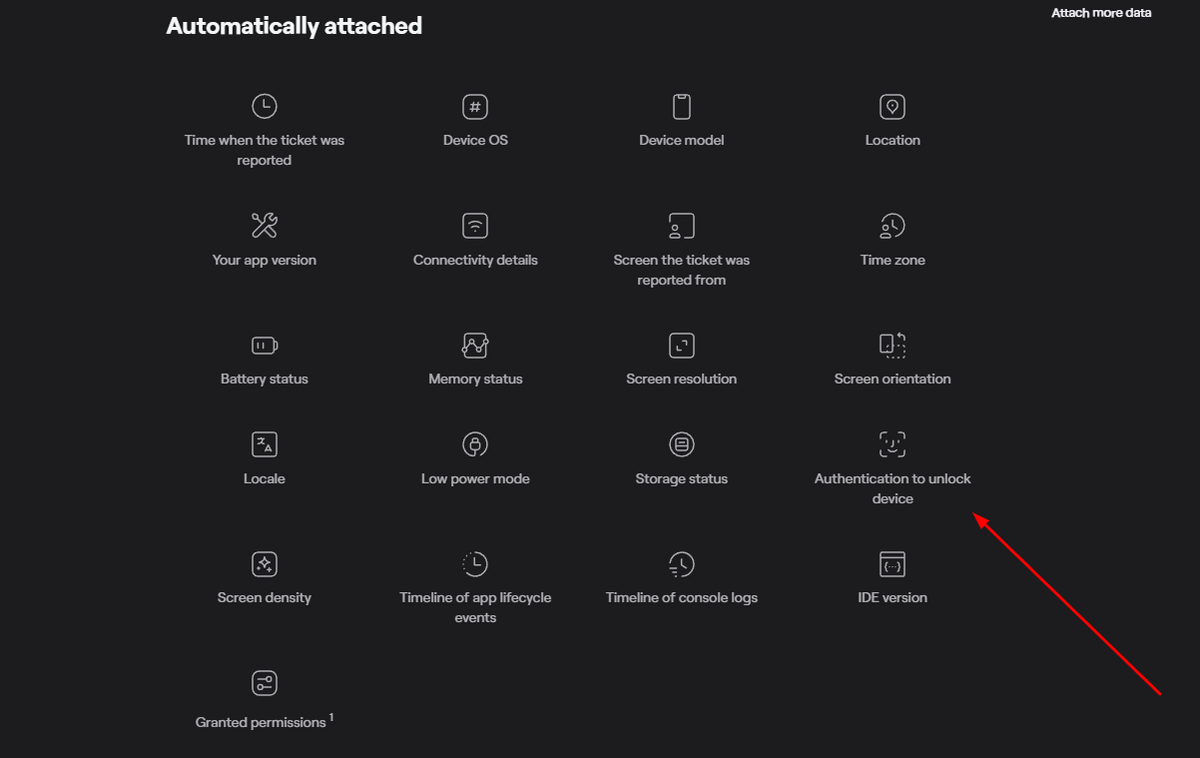
In fact, just like airplanes, Shake has its own black box that logs a detailed environment profile covering the last 60 seconds before a bug is submitted.
As an added bonus, it can also automatically generate screenshots and video recordings of the bug occurring so that developers can see the issue for themselves, as shown below.
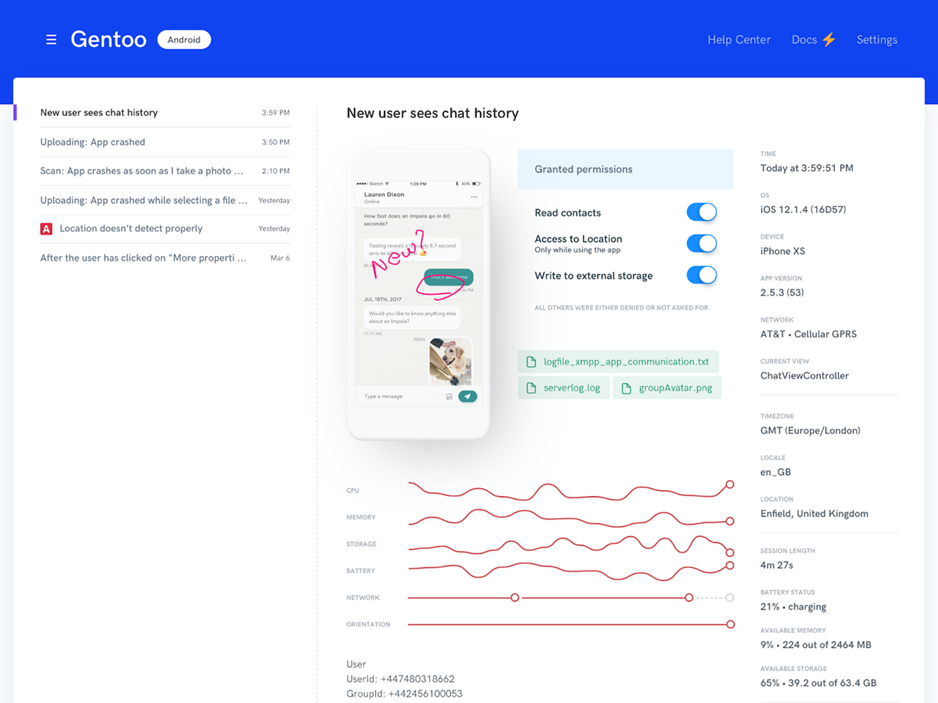
The combination of all this data in bug reports can be invaluable for developers when they’re trying to recreate a bug and understand what caused it.
That’s why bug reporting is a vital part of every testing process and can make all the difference when it comes to helping developers identify the underlying causes of bugs and other technical errors.
What is bug tracking
Bug tracking is an essential component of any software testing process.
It allows for the recording and management of all aspects related to a bug, and also provides a central place to report bugs and track their progress.
However, to better understand the bug-tracking process, it helps to consider how bugs progress through stages, from when they’re first reported until they’re resolved.
As the diagram shows, the life cycle of a bug typically begins when a QA specialist or tester submits a new bug report.
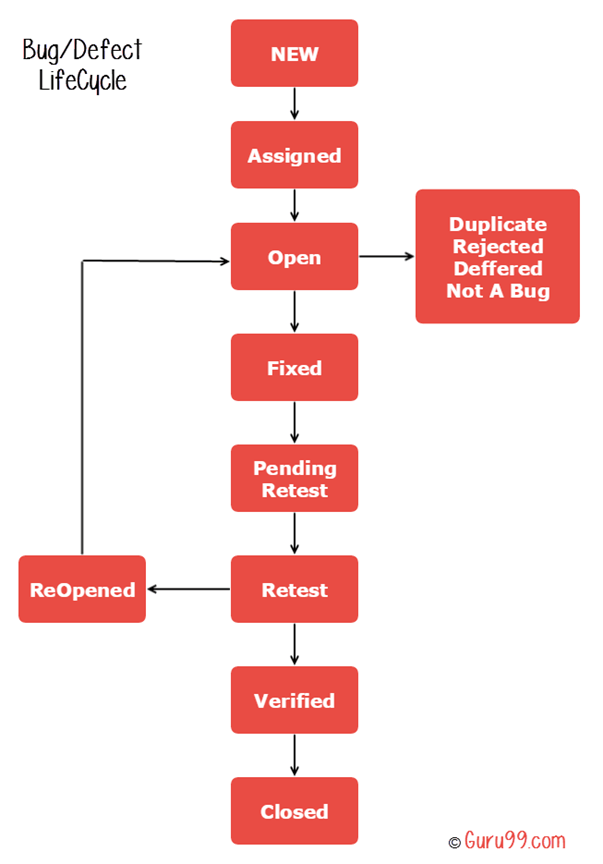
The bug is then entered into a bug-tracking system for further tracking and investigation.
Developers take it from there and begin to analyze the problem.
Once they’ve found the solution and fixed the bug, they’ll forward their work to the QA team for another round of testing.
Finally, when both developers and QA specialists are satisfied with the result, the bug will be marked as closed.
The importance of the bug-tracking process is readily apparent.
First of all, as the image below illustrates, by keeping track of bugs, their severity level, and status (open, to do, in progress, closed, and so on), you can be sure that everyone knows which bugs have been fixed and whether there are still outstanding ones.
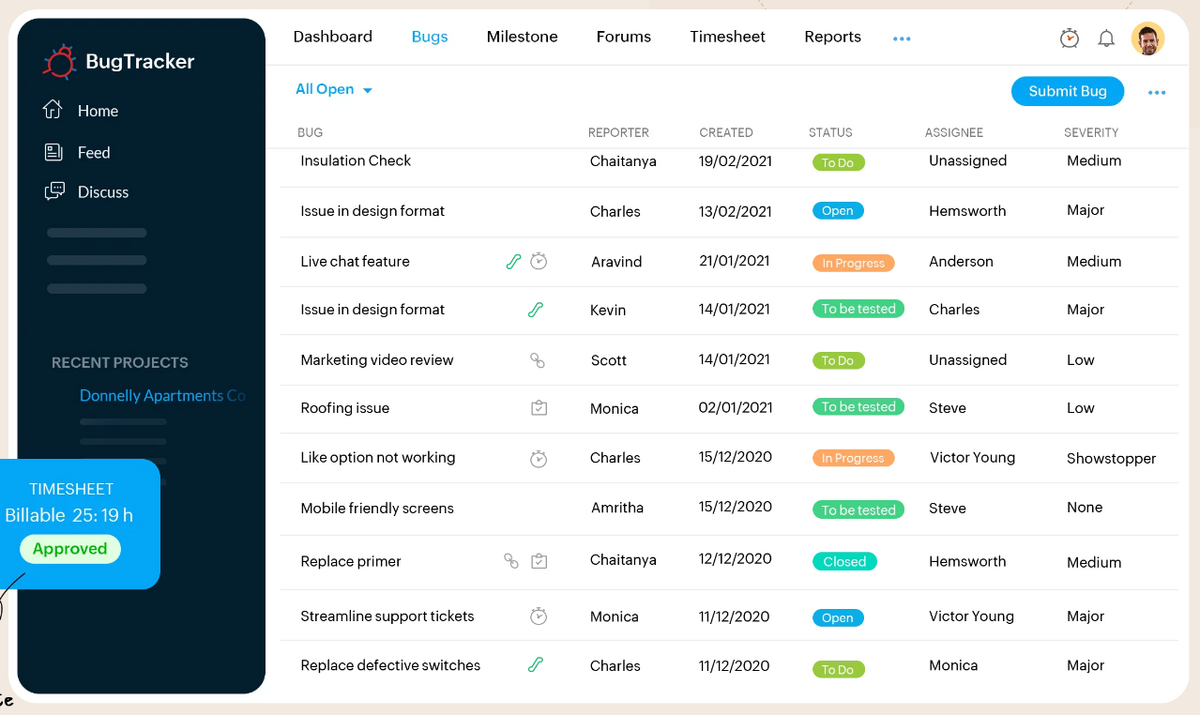
Secondly, if done right, bug tracking allows you to keep track of the time it takes to fix bugs.
This is important because it enables you to plan your projects more effectively and measure how much time it takes for developers to resolve certain types of bugs.
It also helps prevent bottlenecks. If one developer has a lot of tasks on their plate while others have none, then you’ll know who needs help first.
In other words, by following established bug-tracking best practices, you can make sure that everyone is always in the loop and on top of incoming bugs.
The development team will have a clearer picture of what is being reported, and you’ll be able to build a backlog that reflects the most critical bugs.
You can then use this information to prioritize the team’s work and make sure that bugs get fixed in an orderly fashion.
What is issue tracking
Issue tracking is a way of keeping track of errors, bugs, and other flaws that users encounter when interacting with a product.
For instance, these flaws can be a broken button, a confusing design choice, an authentication error, or any other issue that causes some sort of adverse effect on the user.
However, it’s important to note that issue tracking is more than a simple list of user experience defects.
As we already mentioned, issues can also include business requirements and project management problems, as well as technical defects.
All of these issues will be tracked and monitored in one central issue tracker (as the one pictured below), so that all team members can keep informed of their statuses.
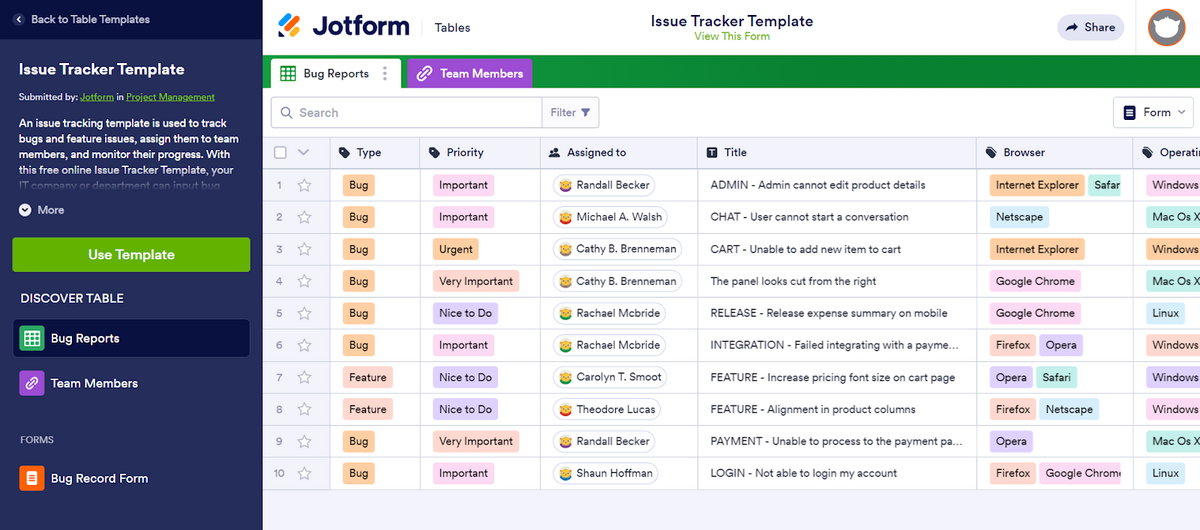
There are a number of different sources that can fuel the creation of issues in the issue tracker. These include:
- User stories (phone calls, live chats, emails, social media comments, web contact forms)
- Tickets from customer support teams
- Reports from QA teams
- Internal feedback from developers, designers, project managers, etc.
A quick glance at the list above shows that, in addition to developers and QA specialists, different stakeholders including project managers, customer support staff, and designers need access to issue tracking.
That means that in many cases the resolution of a problem may require input and collaboration from different teams within the company.
Considering that 90% of users state that immediate issue resolution is important to them, it’s no surprise that fast and efficient issue tracking is a top priority.
This is possible because now multiple teams can work on a particular problem at the same time without duplicating efforts or causing delays in resolving an issue.
Bug reporting vs bug tracking vs issue tracking
The terms bug reporting, bug tracking, and issue tracking are often used as synonyms.
However, there are some subtle differences between these three concepts that are important to understand.
As we’ve seen, bug reporting is the initial stage of identifying and reporting bugs.
QA specialists or testers detect the bug and write the bug report so that the development team can replicate and investigate the problem.
Given that developers spend much of their time fixing bugs and that a well-written bug report can save up to 45% of the time otherwise spent on such work, it’s safe to say that bug reporting is an important part of the software development process.
After the bug reports are submitted, bug tracking takes center stage.
The process involves assigning the bug to a developer, tracking its status, and regularly updating its progress until it’s resolved.
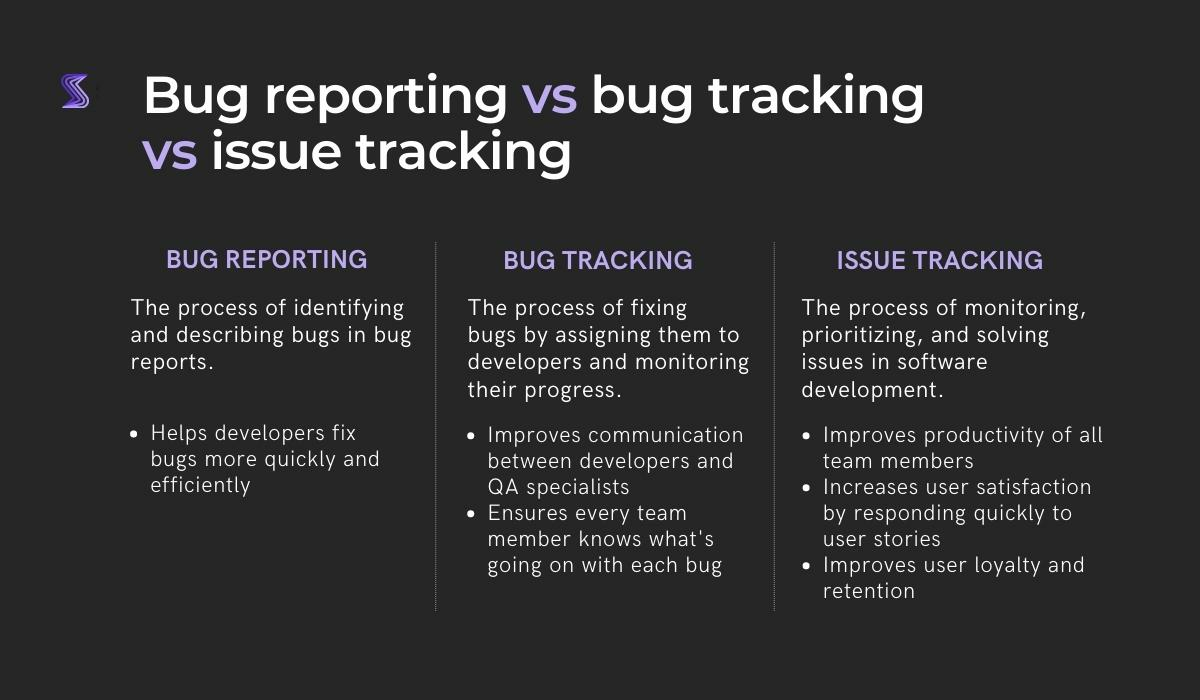
The benefits of using bug-tracking software are huge, as it allows teams to better organize their work and provides a central hub for all information related to bugs.
It also enables QA specialists to collaborate more easily with developers, and it helps identify trends so that bugs can be prevented from happening again.
Finally, issue tracking is like bug tracking, except it encompasses not only bugs but also other types of issues.
That basically means that issue-tracking software can be used to track any flaws that happen during the development process.
This also means that all issues will be collected in one central location, assigned to specific people and clearly defined—all of which equals more organized workflows and better overall collaboration.
However, one of the biggest benefits of issue tracking is that it helps improve user satisfaction.
By tracking user stories, the team can respond to them quickly and efficiently. This can improve the user’s experience, which can lead to greater loyalty and retention.
In summary, while bug reporting focuses on identifying and describing bugs, bug tracking is about managing and resolving those bugs, and issue tracking encompasses a broader range of issues.
Understanding these differences is essential for effective software development and ensuring the quality of software products.
Conclusion
In this article, we’ve looked at bug reporting, as well as bug and issue tracking, and why they are important to development teams.
We’ve also gone into some detail on how these concepts relate to one another in general.
While bug reporting and bug tracking are fairly straightforward concepts, issue tracking is a bit more nuanced because it involves addressing a wider range of issues.
However, each of these processes has its value in software development, and they all help to ensure that the end product is as high quality as possible.





